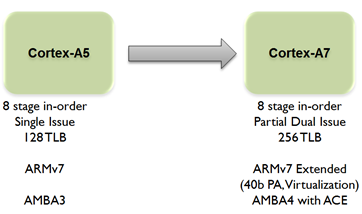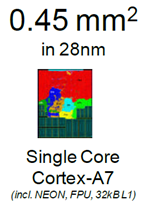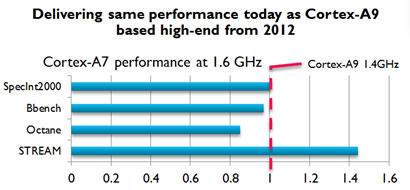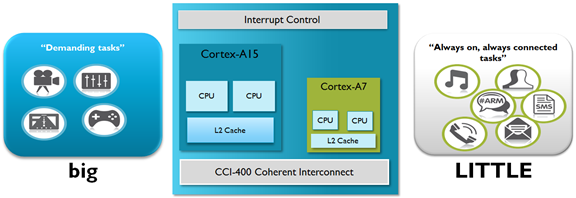The Top 5 Things to Know about Cortex-A7
The ARM Cortex-A7 MPCore processor is the most energy efficient application processor that ARM has ever developed and has dramatically extended ARM’s low-power leadership in entry level smart phones, tablets and other high end mobile devices.&...
By Kinjal Dave
The ARM Cortex-A7 MPCore processor is the most energy efficient application processor that ARM has ever developed and has dramatically extended ARM’s low-power leadership in entry level smart phones, tablets and other high end mobile devices. Here are the top five things to know about Cortex-A7:
Built upon ARM’s high efficiency heritage
The Cortex-A5 (launched in 2009) was designed to fit in a sweet area/power footprint of ARM9 (most licensed processor with about 250 licensees), while delivering significantly higher performance and power-efficiency, and bring it to modern ARMv7 feature set. The Cortex-A7 processor inherits the simple pipeline of Cortex-A5, 8 stages long with in-order execution. However, the Cortex-A7 processor added microarchitecture improvements to increase performance. The performance of Cortex-A7 on a range of benchmarks is 15%~20% higher than Cortex-A5. Like its predecessor Cortex-A5, the Cortex-A7 also offers a small area footprint that is less than 0.5mm2 for a typical 28nm mobile implementation.


Architecturally compatible with Cortex-A15
The Cortex-A7 is fully compatible with the Cortex-A15 processor (which is the highest performance ARMv7-A processor). The Cortex-A7 processor adds architectural enhancements to deliver full software compatibility with the Cortex-A15 CPU. These architectural enhancements include support for virtualization and 40-bit physical address space, and AMBA® 4 bus interfaces. This results in two unique advantages for Cortex-A7:
- Cortex-A7 processor is used as a LITTLE processor with Cortex-A15 in a big.LITTLE system. The identical architecture of big and LITTLE processors is a critical factor in enabling fast task switching between the big and LITTLE CPU
- Enables building of entry level smartphone platforms that consists of features found only in high performance mobile platforms using Cortex-A15 processor. Features like hardware virtualization and large address space are unusual for such a small a CPU, but enables all applications that run on high end processor like Cortex-A15 to run on Cortex-A7 as well.
Similar performance to Cortex-A9: smaller and more efficient too
The Cortex-A7 is widely shipping in entry level and high end mobile devices. The graph shows that a Cortex-A7 based mobile platform shipping today provides a performance similar to Cortex-A9 based high end device from last year. The Cortex-A7 provides significant uplift in memory performance compared to Cortex-A9 which is largely due to its improved memory subsystem.

Leading the multicore revolution in entry level
The Cortex-A7 is widely used in entry level smartphones and tablets (typically in the $100-150 range). Quad core Cortex-A7 mobile devices are very popular in the entry level mobile segment. The sweet spot of maximum performance at sub 100mW power per core makes Cortex-A7 an ideal solution for use as standalone application processor, delivering excellent performance at very low power, area and cost while enabling new features to be supported in these low cost smartphone segments.
Extends the energy efficiency of high end mobile platforms as a LITTLE processor in big.LITTLE processing with Cortex-A15
As I mentioned earlier, the Cortex-A7 is architecturally identical to the high performance Cortex-A15 processor, and can be integrated with it in a big.LITTLE processor subsystem. big.LITTLE enables peak performance and extreme efficiency by distributing work to the right-sized processor for the task at hand. It is described in more detail here.

The diagram above shows Cortex-A7 combined with Cortex-A15 in an example system for high end mobile platforms. The CCI-400 cache coherent interconnect allows the 2 CPU clusters to be combined in a seamless way that allows software to manage the task allocation in a highly transparent way, as described in this whitepaper. The big.LITTLE system enables peak performance at low average power.
To conclude, Cortex-A7 is ideal for use in as a standalone application processor delivering excellent performance in entry level mobile platforms that was available only to high end platforms an year ago. The Cortex-A7 processor can also be integrated with Cortex-A15 in a big.LITTLE processor subsystem- which extends the energy efficiency of high performance mobile platforms while meeting the increasing higher performance demands in these mobile platforms.
By Kinjal Dave
Re-use is only permitted for informational and non-commercial or personal use only.
